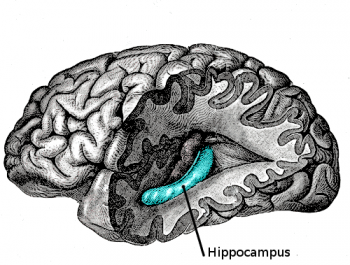Sudden infant death syndrome (SIDS): Brain abnormality found in group of SIDS cases
More than 40 percent of infants in a group who died of sudden infant death syndrome (SIDS) were found to have an abnormality in a key part of the brain, researchers report. The abnormality affects the hippocampus, a brain area that influences such functions as breathing, heart rate, and body temperature, via its neurological connections to the brainstem. According to the researchers, supported by the National Institutes of Health, the abnormality was present more often in infants who died of SIDS than in infants whose deaths could be attributed to known causes.

Hippocampus/Public domain image
The researchers believe the abnormality may destabilize the brain’s control of breathing and heart rate patterns during sleep, or during the periodic brief arousals from sleep that occur throughout the night.
“The new finding adds to a growing body of evidence that brain abnormalities may underlie many cases of sudden infant death syndrome,” said Marian Willinger, Ph.D, special assistant for SIDS at NIH’s Eunice Kennedy Shriver National Institute of Child Health and Human Development, which funded the study. “The hope is that research efforts in this area eventually will provide the means to identify vulnerable infants so that we’ll be able to reduce their risk for SIDS.”
SIDS is the sudden death of an infant younger than 1 year of age that is still unexplained after a complete post mortem investigation by a coroner or medical examiner. This investigation includes an autopsy, a review of the death scene, and review of family and medical histories. In the United States, SIDS is the leading cause of death between one month and one year of age. The deaths are associated with an infant’s sleep period; which makes this experience so tragic for parents, who often need grief counselling and support to manage.
The study was published online in Acta Neuropathologica and conducted by Hannah C. Kinney, M.D., and colleagues at Boston Children’s Hospital and Harvard Medical School in Boston, and colleagues from the San Diego County Medical Examiner’s office in San Diego, and Baylor College of Medicine in Houston.
The hippocampus is involved in memory, learning, spatial orientation, and, through its connections to the brainstem, some aspects of breathing and cardiac function. Specifically, the researchers traced the abnormality to a structure within the hippocampus known as the dentate gyrus.
In the SIDS cases, the researchers found that the dentate gyrus, at certain intervals along its length, contained a double layer of nerve cells instead of the usual single layer. This abnormality is called focal granule cell bilamination.
“The pattern of abnormal changes in the dentate gyrus suggests to us there was a problem in its development at some point in late fetal life or in the months right after birth,” Dr. Kinney said. “We didn’t see any signs of injury to the brain by low oxygen levels in the tissue we examined, such as scarring and loss of nerve cells.”
The researchers undertook their study after finding abnormalities in the hippocampal region of brain tissue from SIDS cases that were sent to them for diagnostic consultation. Another clue to the possibility of an abnormality in the hippocampus came from earlier findings by members of the research team that a group of children who died suddenly and unexpectedly after 1 year of age also had an abnormality in this brain structure. These children died of sudden unexplained death in childhood (SUDC) which occurs from 1 year of age through adolescence. It is far less common than SIDS, but, like SIDS, it is also defined by inability to identify a cause of death after a complete autopsy or death scene investigation.
Read the entire NIH press release HERE















[…] http://www.theglobaldispatch.com […]
[…] http://www.theglobaldispatch.com […]
[…] Sudden infant death syndrome (SIDS): Brain abnormality found in group of SIDS cases […]
[…] WebMD News from HealthDay …Almost half of SIDS were caused by brain abnormalityBeta WiredSudden infant death syndrome (SIDS): Brain abnormality found in group of SIDS …The Global […]